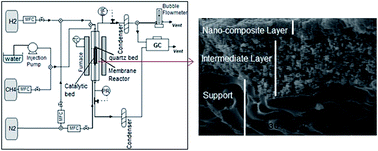Tubular silica/alumina membranes with three different thicknesses of selective layer (75–100 nm) were successfully applied as membrane reactors for simultaneous production and purification of hydrogen. BET analysis indicated a decreasing trend in membrane characteristics by adding successive layers, which is well in agreement with the graded structure of the substrate. These membranes showed a high permeance of 5–11 × 10−7 mol m−2 s−1 Pa−1 and good separation factor of 20–300 at various temperatures (773–1073 K) in an equimolar mixture of H2, CH4, CO, and CO2. The reactor performance of the membranes was evaluated for the methane steam reforming (MSR) reaction – using a conventional nickel/alumina catalyst with 10 wt% of nickel on the alumina support – in the reaction temperature range of 773–1073 K and pressure range of 1–10 bar. X-ray diffraction measurements of the catalyst showed a good dispersion of nickel on the alumina substrate. The reactor results showed an increasing trend for H2 yield between 3.8–30 × 10−6 mol g−1 with both increasing temperature and pressure, but CH4 conversion decreased about 30% with increasing pressure from 1 to 10 bar. These results also indicate higher values of hydrogen yield and methane conversion in comparison to the equilibrium conditions for all membranes even up to 35% by increasing either temperature or pressure.

